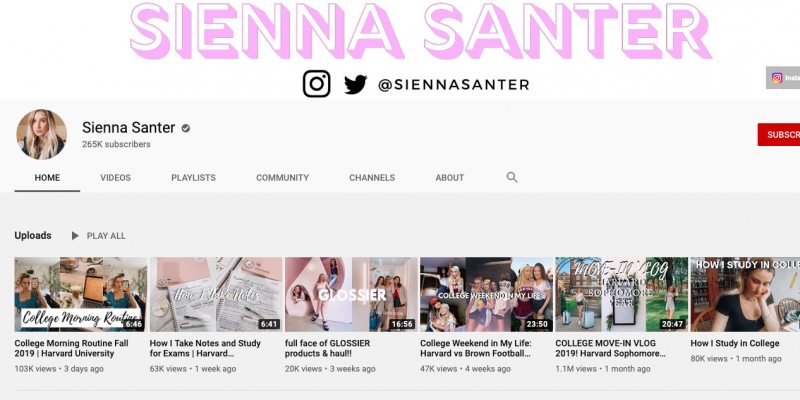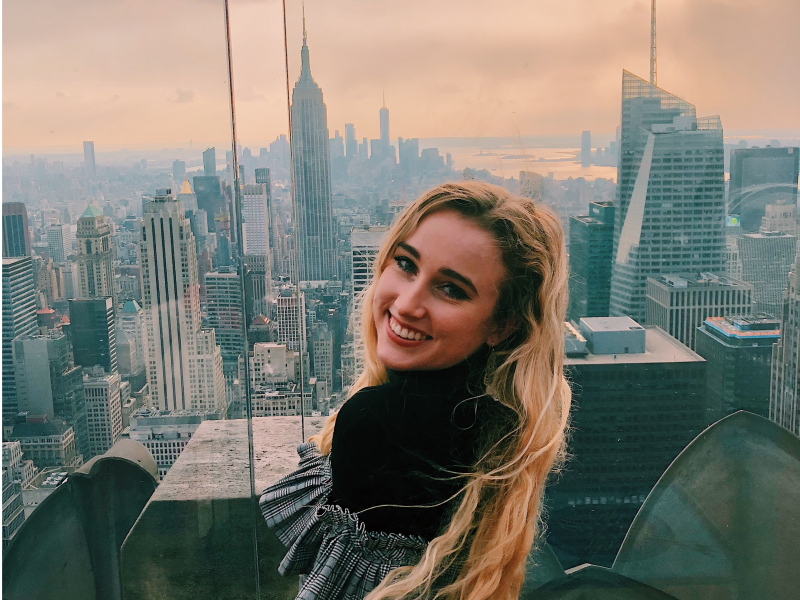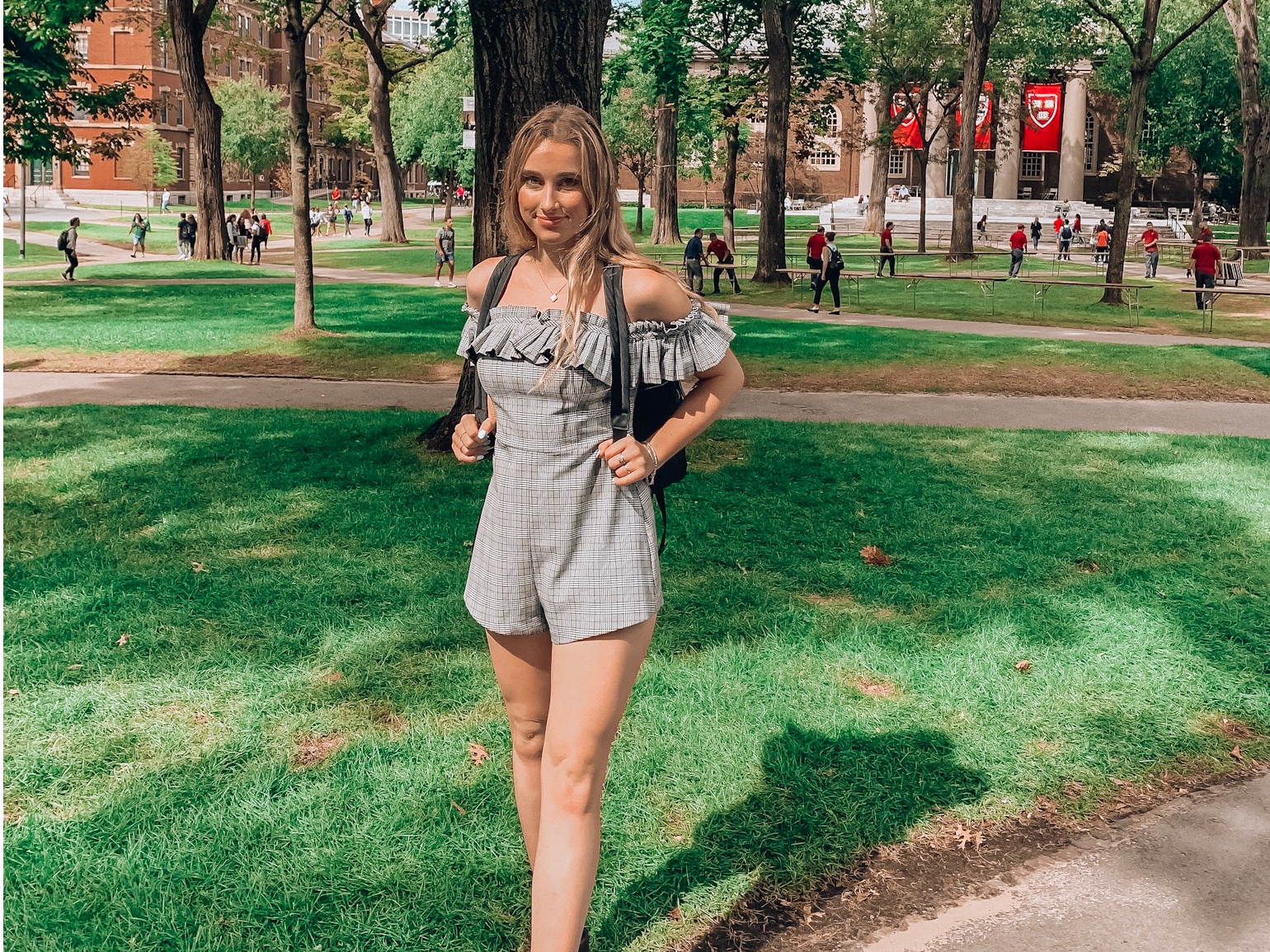- Sienna Santer is a second-year Harvard student and a YouTube influencer with 265,000 subscribers.
- Santer’s channel blew up after she uploaded a video moving into her college dorm room at Harvard, which now has 4.7 million views.
- Santer’s channel quickly turned into a real business. She signed with a manager and earns money through brand sponsorships on social media and from ads on YouTube.
- Click here for more BI Prime stories.
Sienna Santer’s YouTube influencer career all started with friends and family members asking her how she got accepted into Harvard.
“I had so many people asking how I got in and if I could give them advice,” she said. “Instead of writing back and forth, I decided to put everything into a video and send that to them.”
Using the research from her application process, Santer sat down in August 2018 and filmed her second YouTube video (her first was a travel vlog from a recent trip to Prague), which she assumed only close friends and interested family members would watch.
After posting the video, Santer said, she put YouTube on hold, and as the weeks went on, she fully immersed herself into her freshman year and forgot all about her channel.
Santer returned to her channel in December and edited together clips she filmed while moving into her dorm room.
"I wasn't thinking much of it," she said. "I edited the video, and posted it in December, thinking it wouldn't make sense months later, but who cares."
One week later, Santer logged back into YouTube and saw that her video, titled "COLLEGE MOVE-IN VLOG! Freshman Year at Harvard University," had gained over 1 million views.
"That was insane to me," she said, and in less than one year, Santer has become a popular YouTube influencer, recognized around campus with 265,000 subscribers.

'I was always drawn to YouTube'
Growing up, Santer said, she always dreamed of being a "YouTuber." (She's not alone, as YouTube creator has become a popular dream job for kids.)
"I was always drawn to YouTube," she said. "In high school, I watched YouTube on the regular. It was like my Netflix."
The YouTube management group Table Rock Management reached out to Santer in December, before she posted her Harvard move-in vlog, she said.
"I had about 2,000 subscribers, but wasn't really doing anything with my channel," she said. "They reached out and said: 'Hey, we see potential in your channel. We think this could be something big.'"
Santer said she took about a month to think the decision over and signed with them during her winter break, opening up sponsorship and brand-deal opportunities.
"That was a big transition," she said. "The videos weren't just for me. Now I had to be accountable to brands, which taught me a lot about running my own business."
Santer is part of a rising trend of YouTubers becoming famous for sharing their college experiences - especially their move-in videos, which can rack up millions of views. Margot Lee, a Syracuse student with 425,000 YouTube subscribers, even teaches an informal pop-up class on becoming a professional influencer to her classmates (and shared her slides with Business Insider).

From a viral video to an online business that helps cover college expenses
Santer's channel quickly went from a few viral videos into a full-blown online business.
"A lot of my loyal subscribers have been with me since that move-in vlog," she said.
Signing with a management group helped her land brand sponsorships with companies like Audible and the vitamin company Care/of.
"It's helped me finance college," she said about her YouTube channel. "It's how I pay for my tuition - everything."
Some of Santer's college friends have part-time jobs at bookstores and waitressing on weekends to help pay for food and student loans. Her job is YouTube.
"My channel has helped me deal with things a lot earlier than some of my friends and helped me a lot with money-management skills," she said. "I have checks for AdSense coming in the mail that I have put aside for taxes, retirement, savings."
On YouTube, creators earn money from ads placed on videos by Google, called AdSense, and how much a creator earns per video depends on views, watch time, and viewer demographics.
For brand sponsorships, the typical rate creators will go by when starting out is $100 per 10,000 followers, according to several Instagram influencers interviewed by Business Insider.
Santer, who has 20,000 followers on Instagram, didn't specify how much she earned through sponsorships. But Caitlin Patton, an influencer who previously spoke with Business Insider who has about the same number of Instagram followers as Santer, said she earned about $2,000 for a sponsorship campaign (photo and Story combination).
While Santer spends a lot of time working on her YouTube channel and influencer career, she also lets her management handle much of the business end.
"I really wanted to have management because I knew I would be so busy as a college student," Santer said. "A lot of the negotiations that happen with brands all happen with my management."
Santer said she eventually planned to learn more about the business aspects of her channel, but for now her management priced her deals for her while she focused on college.
"I have to trust them a lot," she said. "Many times they are very objective - it's up to me to decide whether an opportunity is worth it."
For more on how to become a successful influencer, according to YouTube and Instagram stars, check out these Business Insider Prime posts:
- YouTube creator Natalie Barbu breaks down how much money she earns from a video with 100,000 views: Barbu, a social-media influencer and YouTube creator with 227,000 subscribers, shared how much money she earned from a video with 100,000 views.
- YouTube star Shelby Church breaks down how much money a video with 4 million views made her: The YouTube creator Church, who has 1.3 million subscribers, broke down how much she earned in Google AdSense from a video with 4 million views.
- How much money you can make from a sponsored Instagram post with 24,000 followers: The Instagram influencer Caitlin Patton, who has 24,900 followers, broke down how she determined her rates as a microinfluencer.
